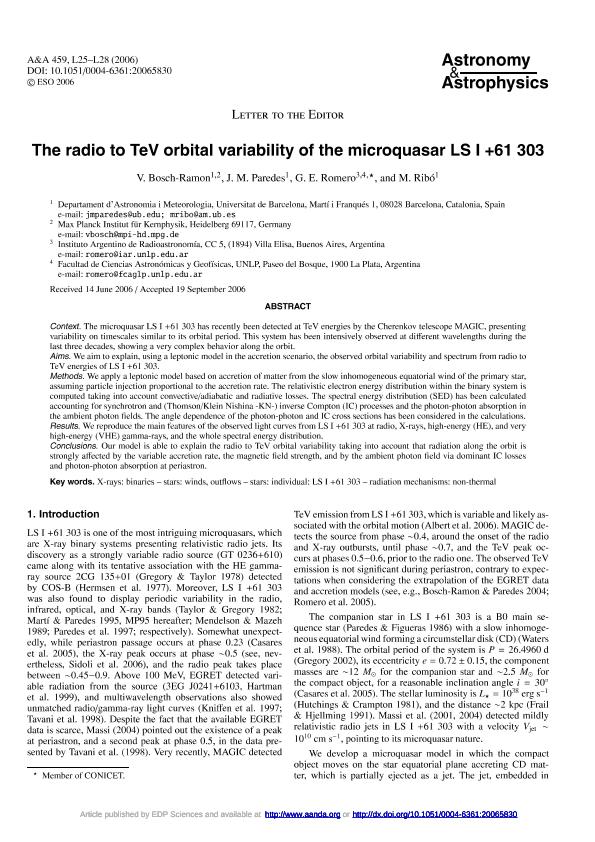Mostrar el registro sencillo del ítem
dc.contributor.author
Bosch Ramon, Valentí

dc.contributor.author
Paredes, Josep Maria

dc.contributor.author
Romero, Gustavo Esteban

dc.contributor.author
Ribó, Marc
dc.date.available
2017-11-30T16:10:20Z
dc.date.issued
2006-11
dc.identifier.citation
Bosch Ramon, Valentí; Paredes, Josep Maria; Romero, Gustavo Esteban; Ribó, Marc; The radio to TeV orbital variability of the microquasar LSI+61303; EDP Sciences; Astronomy and Astrophysics; 459; 2; 11-2006; 25-28
dc.identifier.issn
0004-6361
dc.identifier.uri
http://hdl.handle.net/11336/29333
dc.description.abstract
Context: .The microquasar LS I +61 303 has recently been detected at TeV energies by the Cherenkov telescope MAGIC, presenting variability on timescales similar to its orbital period. This system has been intensively observed at different wavelengths during the last three decades, showing a very complex behavior along the orbit.Aims: .We aim to explain, using a leptonic model in the accretion scenario, the observed orbital variability and spectrum from radio to TeV energies of LS I +61 303.Methods: .We apply a leptonic model based on accretion of matter from the slow inhomogeneous equatorial wind of the primary star, assuming particle injection proportional to the accretion rate. The relativistic electron energy distribution within the binary system is computed taking into account convective/adiabatic and radiative losses. The spectral energy distribution (SED) has been calculated accounting for synchrotron and (Thomson/Klein Nishina -KN-) inverse Compton (IC) processes and the photon-photon absorption in the ambient photon fields. The angle dependence of the photon-photon and IC cross sections has been considered in the calculations.Results: .We reproduce the main features of the observed light curves from LS I +61 303 at radio, X-rays, high-energy (HE), and very high-energy (VHE) gamma-rays, and the whole spectral energy distribution.Conclusions: .Our model is able to explain the radio to TeV orbital variability taking into account that radiation along the orbit is strongly affected by the variable accretion rate, the magnetic field strength, and by the ambient photon field via dominant IC losses and photon-photon absorption at periastron.
dc.format
application/pdf
dc.language.iso
eng
dc.publisher
EDP Sciences

dc.rights
info:eu-repo/semantics/openAccess
dc.rights.uri
https://creativecommons.org/licenses/by-nc-sa/2.5/ar/
dc.subject
X Ray Binaries
dc.subject
Star Winds
dc.subject
Outflows
dc.subject
Ls I +61 303 (Estrella)
dc.subject
Radiation Mechanisms
dc.subject
Non Thermal Mechanisms
dc.subject
Microquasars
dc.subject.classification
Astronomía

dc.subject.classification
Ciencias Físicas

dc.subject.classification
CIENCIAS NATURALES Y EXACTAS

dc.title
The radio to TeV orbital variability of the microquasar LSI+61303
dc.type
info:eu-repo/semantics/article
dc.type
info:ar-repo/semantics/artículo
dc.type
info:eu-repo/semantics/publishedVersion
dc.date.updated
2017-10-12T19:37:50Z
dc.journal.volume
459
dc.journal.number
2
dc.journal.pagination
25-28
dc.journal.pais
Francia

dc.journal.ciudad
Paris
dc.description.fil
Fil: Bosch Ramon, Valentí. Universidad de Barcelona; España
dc.description.fil
Fil: Paredes, Josep Maria. Universidad de Barcelona; España
dc.description.fil
Fil: Romero, Gustavo Esteban. Provincia de Buenos Aires. Gobernación. Comisión de Investigaciones Científicas. Instituto Argentino de Radioastronomía. Consejo Nacional de Investigaciones Científicas y Técnicas. Centro Científico Tecnológico Conicet - La Plata. Instituto Argentino de Radioastronomía; Argentina
dc.description.fil
Fil: Ribó, Marc. Universidad de Barcelona; España
dc.journal.title
Astronomy and Astrophysics

dc.relation.alternativeid
info:eu-repo/semantics/altIdentifier/url/http://www.aanda.org/component/article?access=bibcode&bibcode=&bibcode=2006A%2526A...459L..25BFUL
dc.relation.alternativeid
info:eu-repo/semantics/altIdentifier/doi/http://dx.doi.org/10.1051/0004-6361:20065830
Archivos asociados
